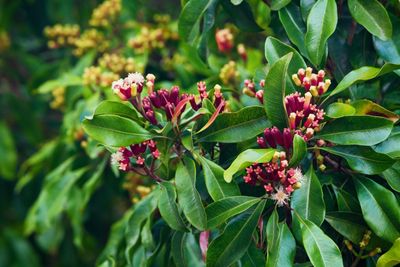Clove Tree Diseases
Below are the most prevalent diseases that affect clove trees. Sudden Death – Sudden death disease of clove trees is a major fungal disease that affects the absorbing roots of mature clove trees. Seedlings are immune to the disease and young trees are highly resistant. The only warning of sudden death disease is chlorosis, which refers to yellowing of the leaves due to lack of chlorophyll. Death of the tree, caused when the roots are unable to absorb water, may occur in a few days or may take several months. There is no easy cure for sudden death disease, which is spread by waterborne spores, but clove trees affected are sometimes injected with repeated injections of tetracycline hydrochloride. Slow Decline – Slow decline disease is a type of root rot that kills clove trees over a period of several years. Experts believe it is associated with sudden death disease, but affects only saplings, often in areas that have been replanted after clove trees have succumbed to sudden death. Sumatra – Sumatra disease is a bacterial disease that generally leads to death of clove trees within three years. It causes yellowing leaves that may wilt or drop from the tree. Grayish brown streaks may appear on new wood of diseased clove trees. Experts believe Sumatra disease is transmitted by Hindola fulva and Hindola striata – two types of sucking insects. There is currently no cure, but pesticides control the insects and slow the spread of the disease. Dieback – Dieback is a fungal disease that enters the tree through a wound that occurs on a branch and then moves down the tree until it reaches the junction of the branch. All growth above the junction dies. Dieback often occurs after the tree is injured by tools or machinery or by improper pruning. Branches of diseased clove trees should be removed and burned, followed by treatment of the cut areas with a paste-type fungicide.
Preventing Clove Tree Diseases
Although this tropical tree requires regular irrigation during the first three or four years, it’s critical to avoid overwatering to prevent fungal diseases and rot. On the other hand, never allow the soil to become bone dry. Rich, well-drained soil is a must as well. Clove trees aren’t suitable for climates with dry air or where temperatures drop below 50 degrees F. (10 C.).
